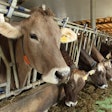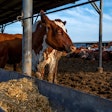U.S. cattle feedlots are expecting slight losses in 2013 in the wake of high livestock feed costs, according to Michael Swanson, an agricultural economist at Wells Fargo & Co.
The U.S. herd reached a 61-year low after the 2012 drought, the worst drought since the 1930s and one which sent corn prices to an all-time high. “Economically, we use price to ration or to increase supply,” said Swanson. “Our supply is that much more constrained.” Cattle prices rose to a record $1.35175 a pound on the Chicago Mercantile Exchange on January 11. In 2012, futures climbed 8.9 percent, the fourth straight increase.
Higher animal weights have tempered the decline in the size of the herd, supporting beef production, said Swanson. Average steer weights were 1,503 pounds on February 4 and February 5, up 1 percent from the same days in 2012, according to U.S. Department of Agriculture data. But meatpackers may not allow weights to go up, as heavier animals yield more fat that can’t be sold, and high corn costs make raising beefier cattle less attractive, said Swanson.












